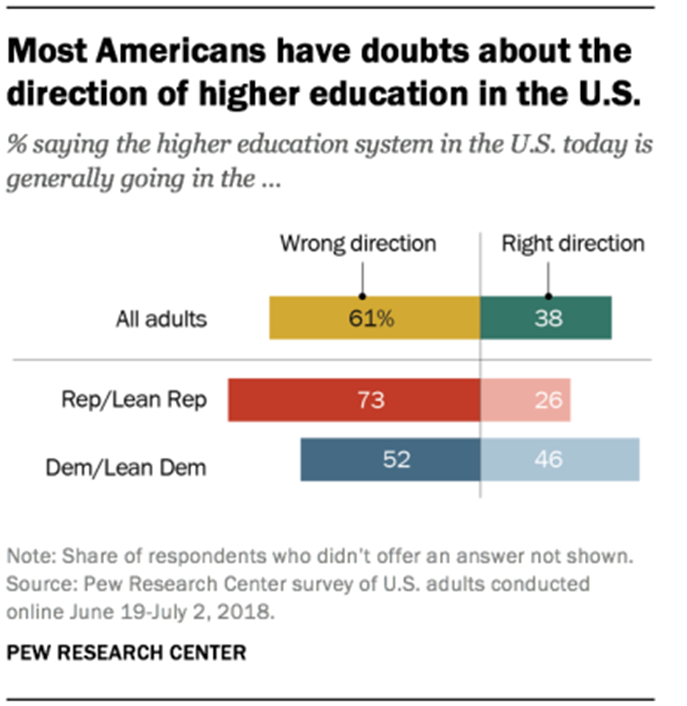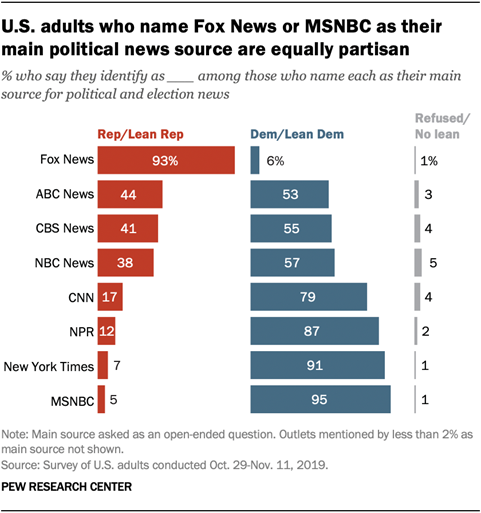
The role of politics, and an instructor’s personal political leanings, in teaching, has been a hot topic of debate over a couple of decades, with politicians and spokespeople from both sides of the aisle accusing instructors of trying to indoctrinate the youth of our nation. In fact, one study went so far as to show that a majority of Americans have doubts about the current direction of U.S. education.

Source: Pew Research Center
Which begs the question. Is it truly possible for instructors to maintain neutrality in an increasingly polarized world, and if so, how? It’s questions like these that instructors and administrators across the nation are forced to confront when considering the issue of bias in the classroom. While there are no easy solutions to balancing partisanship with education, there are things we can do to try and maintain a neutral position, without sacrificing our own beliefs.
So What can You do to Maintain Neutrality?
While it may seem impossible to achieve neutrality in the polarized world of today, there are things you can do to try and present a more neutral view of events, without sacrificing your personal values.
Tip 1: Using Neutral Language
It’s easy to get heated up when talking about issues that are important to you. When we get passionate we have a tendency to use more expressive language that praises the views and opinions we support and diminishes those we do not. This can lead to students feeling preached to, instead of teached to.
One of the best ways you can maintain neutrality is through your language, and with a few simple word changes, a partisan statement on the state of police in America can become an opening for a more balanced discussion.
Some examples of neutral language include:
- Leaving out words that pass judgment, like calling a politician’s decision “good” or “bad
- Distancing yourself from the situation, by using phrases like “some say” or “some argue”
- Avoiding harsh language, like referring to an action as “stupid” or “thoughtless”
Remember, to breathe deeply when you notice competing emotions within yourself arise, so that you may better communicate the objective and neutral language you know your students deserve.
Tip 2: Stick to the Facts
It can be easy to want to state your opinion when tackling a current event in class. An easy way to avoid allowing too many of your political leanings to leak into your lecture is to focus on the facts or reporting. If you’re talking about a contested partisan event, you might want to focus on the actions taken by both sides and the statements made by them, instead of arguing in favor of one or the other. For example, simply state what happened instead of how you feel about it, like “Today, Kevin McCarthy was announced as the Speaker of the House. This is what both sides said about it…”
Tip 3: Share Opposing Viewpoints
Maintaining neutrality doesn’t mean you have to avoid politics entirely. When tackling hot-button issues, talk about all sides of the issue to provide a more thorough and neutral understanding of the issue that allows students to come to their own conclusions.
Tip 4: Encourage Group Discussion
When tackling tough political topics, take the opportunity to start a class discussion. This gives you the opportunity to express your own leanings while opening the door for opposing views and allowing everyone in the room to see the issue from multiple perspectives.
Tip 5: Create a Safe Space for Sharing Contrasting Opinions
It’s important when trying to facilitate any sort of group discussion or debate around a political issue, that you create an environment that is both safe and respectful of differing opinions. Take the time to lay some ground rules for your class and make it clear that raising one’s voice or insulting another person’s views will not be tolerated before beginning the discussion.
By giving everyone the space to speak their opinions, even if they go against the majority, you’ll be able to transform your classroom into a more neutral forum for discussion, allowing for a greater amount of critical thinking about the issue.
Tip 6: Keep in Mind the Political Leanings of Your Sources
Research has shown that the media a person consumes is influenced by their political leanings, something to keep in mind when trying to maintain neutrality in the classroom. Take some time to reflect on why you chose the sources you chose, and to diversify the sources you use. If you have a tendency to only show news clips from FOX, try CNN, and if you’re a fan of CNN, try FOX.
 Source: Pew Research
Source: Pew Research
Tip 7: Choose Sources that are Credible
While choosing a variety of sources can help ensure that no single political bias dominates your lessons, it’s important that these sources are credible. By choosing to instruct with material that is unreliable and factually incorrect, you run the risk of parroting opinion-heavy and fact-light interpretations of events. This makes picking and choosing which sources are credible enough to base your lectures on an essential component of maintaining neutrality as an instructor.
Some examples of credible sources include:
- More center-leaning mainstream news outlets
- Government publications and websites
- Peer-reviewed scholarly articles
- Well-known think tanks (e.g., Pew Research Center)
Tip 8: Address the Topic of Bias Head On
A great way of tackling the issue of bias together with your students is by addressing it outright. Take a moment to talk to your students about the ways bias can manifest itself in the media, and remind them to challenge you if they feel your political leanings and seeping too far into your lesson plans.
By talking to your students directly, you can not only help them help you maintain neutrality in the classroom but remind them to think critically about the knowledge they take in and the biases that may be influencing it.
Tip 9: Educate your students on the existence of bias in all media
By educating your students about the ways political bias can manifest itself everywhere, you can teach them to better spot and overlook any biases in your own courses. A political bias indicator like Biasly News Checker can make this easy by calculating the bias of different articles and allowing for students to see for themselves how big a role bias plays in the media we consume.
Tip 10: Learn How Bias can Present Itself in Teaching
While all these tips can help to reduce the bias that you can see, bias presents itself in various ways, many of which take a lot more practice to spot. Biasly’s Media Literacy Education Platform can not only help you learn how to better spot bias in media but can give you a better understanding of the different ways a person’s political leanings could change how they interact with the world. By taking the next step to stay informed, you’ll be better able to create and monitor your own lesson plans to ensure you’re maintaining a balanced stance in the classroom.
Conclusion
So is it possible to maintain neutrality as an instructor?
While we may never be able to fully free ourselves from the biases our personal political leanings create, there are things that can be done both in and outside of the classroom to maintain a positive neutral learning environment.
While trying to stay neutral in a setting that might challenge your personal beliefs may be difficult, maintaining neutrality in the classroom can lead to greater amounts of critical thinking, and discussions that are more beneficial for everyone involved, allowing for a less partisan and more cooperative society.
Disclaimer: Pew Research Center bears no responsibility for the analyses or interpretations of the data presented here. The opinions expressed herein, including any implications for policy, are those of the author and not of Pew Research Center.


























